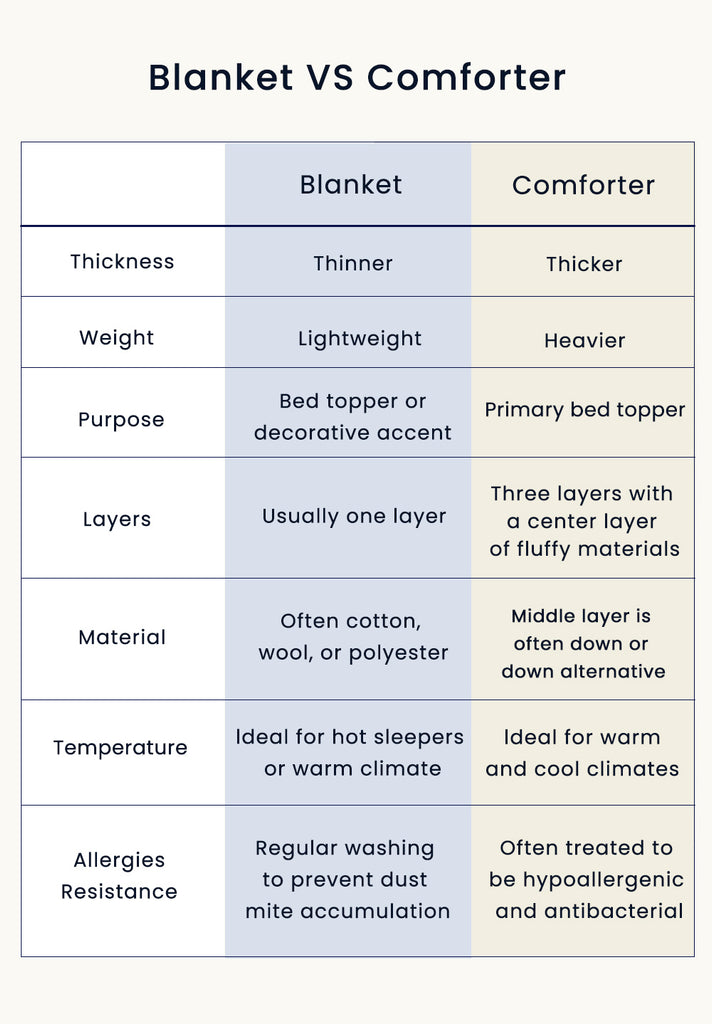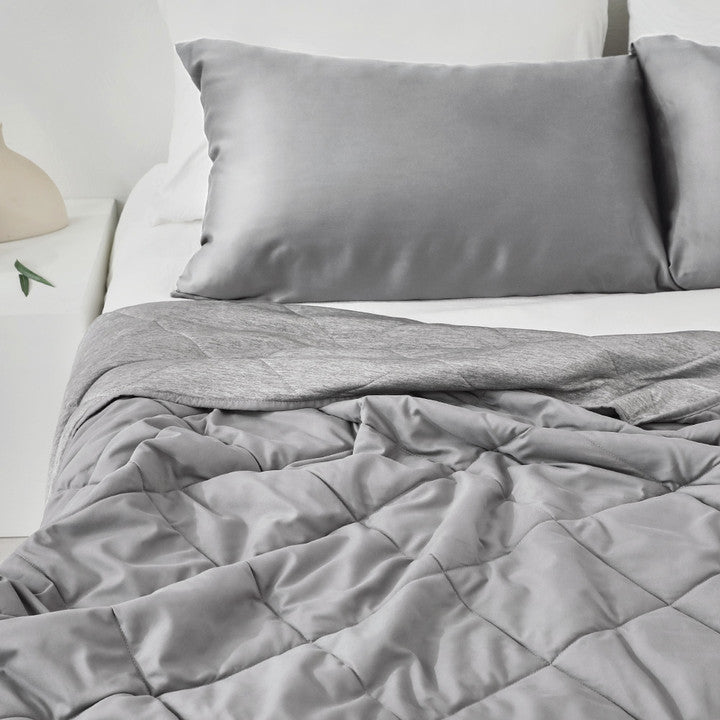The ever-ongoing debate of blanket vs. comforter is not just about picking a side but understanding which best suits your sleep needs. Both have unique benefits and uses, but what if you could find a solution that blends the best of both worlds?
This guide will explore the nuances of choosing between a blanket and a comforter and introduce you to a game-changing product that might end this debate for you.
Blanket vs Comforter: Decoding the Differences
Understanding the distinction between blankets and comforters is crucial for making an informed bedding choice. Blankets are typically a single layer of fabric, offering light to medium warmth and can be layered for increased comfort. They come in various materials, including wool, cotton, and fleece, each providing a different texture and warmth.
Comforters, contrastingly, are thick, quilted blankets filled with synthetic fiber to trap heat efficiently. They're designed to be the top layer of your bedding, providing substantial warmth. Comforters often come as part of a coordinated set with matching pieces, offering both function and style to your bedroom.

Seasonal Considerations in the Blanket vs Comforter Debate
The debate isn't just about personal preference and practicality across different seasons. Light blankets are perfect for warmer months or those who prefer less warmth during sleep.
Meanwhile, a comforter becomes almost indispensable in colder months, offering the necessary insulation for a cozy night's rest.
Understanding Warmth Levels and Weight
Beyond material, the warmth and weight of blankets and comforters are crucial to consider. Blankets generally offer a scalable warmth option, allowing users to layer multiple blankets to achieve the desired comfort level without significantly increasing weight. This versatility is a significant advantage, especially in regions with fluctuating temperatures.
Comforters, with their quilted construction, inherently provide a higher level of warmth and are often rated by "fill power" – a measure of the loft and insulating properties of the down or synthetic fill. Choosing the right comforter involves balancing the warmth it provides with its weight, ensuring it meets your comfort threshold without being overly cumbersome.
Aesthetic and Design Considerations
While functionality is vital, the aesthetic and design aspects of blankets and comforters should be noticed. Blankets often come in various colors, patterns, and textures, allowing for easy swaps according to season or decor changes.
They can add a splash of color or a textural element to a room without the commitment of a larger bedding set.
Comforters, typically part of a matching bedding set, offer a more unified and cohesive look to your bedroom decor. They can serve as the bedroom's centerpiece, dictating the room's color scheme and style.
The choice between a blanket and a comforter reflects a desire to curate a specific aesthetic, whether it's the layered, eclectic look achievable with blankets or the streamlined, coordinated appearance of a comforter set.
Maintenance and Cleaning
Blankets are generally easier to care for due to their lighter weight and less bulky nature. Many are machine washable and can be dried relatively quickly, making them convenient for regular cleaning.
Comforters, on the other hand, require more care due to their bulk and filling material. And while they offer the ease of being machine washable in cold water on a gentle cycle, not all comforters are as simple to maintain. Some may require professional cleaning, especially if they are filled with natural down or are particularly large.
Material and Insulation
The choice of material significantly affects the thermal insulation properties of blankets and comforters. Blankets are typically made from a single layer of material, such as wool, cotton, or fleece, offering varying degrees of warmth.
Comforters are designed with multiple layers and filled with materials like synthetic fibers, down, or a blend, providing excellent insulation.
Allergies and Dust Mites Resistance
Choosing between a blanket and a comforter becomes even more crucial for those concerned with allergies and dust mites.
Comforters are often treated to be hypoallergenic and antibacterial, making them a safer choice for allergy sufferers. Using organic materials also adds a layer of natural resistance against allergens and bacteria.
Blankets can also be hypoallergenic, depending on their material. Cotton and fleece are generally considered safe for those with allergies, but the key is regular washing to prevent dust mite accumulation.
Versatility and Usage
Versatility is where blankets generally shine. They can be used year-round, layered for added warmth in winter, or as a covering in warmer months. Blankets can also easily transition beyond the bedroom, making them ideal for couch snuggles or outdoor events.
Comforters are typically used as a bed's main covering. Their aesthetic appeal contributes significantly to bedroom décor.
The Evolution of Bedding: Adapting to Modern Needs
As we navigate the nuances of choosing between blankets and comforters, we must acknowledge the evolution of bedding solutions in response to modern lifestyles and environmental challenges.
Today's bedding market not only offers a variety of materials and designs but also incorporates technology to enhance sleep quality. This evolution reflects a broader trend towards personalized comfort, addressing everything from temperature regulation to environmental sustainability.
The Best Combination: Cooling Comforter
The focus on temperature regulation in bedding has led to significant advancements. Research indicates that maintaining a consistent sleeping temperature is crucial for quality sleep. Cooling comforters, like the Zonli Home Z-Magic Cooling Comforter, showcase this progress.
These comforters are designed for those who tend to overheat at night. They combine advanced materials and natural fibers to create a cooler sensation compared to blankets. Despite their cooling effect, the breathable fill maintains a lightweight feel while providing the cozy wraparound experience of a traditional comforter.
This feature makes the Z-Magic Cooling Comforter ideal for warmer seasons and individuals with night sweats. Its inclusion in bedding selections reflects a growing demand for tailored solutions that enhance overall sleep quality.
Sustainability and Bedding Choices
Another aspect of the modern approach to bedding is the increasing emphasis on sustainability. Consumers are more conscious than ever of their environmental impact, including their bedding choices.
Organic, recycled, and sustainably sourced materials are becoming popular in blankets and comforters, reflecting a shift towards eco-friendly consumer choices. The integration of such materials into products like a cooling comforter further aligns with the desire for products that are not only functional but also environmentally responsible.
Health and Wellness Considerations
The health and wellness movement has significantly influenced bedding choices, with a growing demand for products that support a healthy sleep environment.
It includes hypoallergenic and antimicrobial materials that help reduce allergens and bacteria in the sleep space. Cooling comforters that incorporate hypoallergenic properties offer an added benefit for health-conscious individuals, providing comfort without compromising health considerations.
Innovation and Personalization
The future of bedding seems poised for continued innovation, focusing on personalization. Smart bedding, capable of adjusting temperature, firmness, and even sleep position, is on the horizon, promising an even more tailored sleep experience.
In the meantime, products like cooling comforters represent a step towards this future, offering specialized solutions that cater to individual preferences and needs.
Integrating technology, sustainability, and health considerations into bedding choices reflects a holistic approach to sleep wellness.
As consumers become more informed and discerning, the options available will likely continue to evolve, offering ever more sophisticated solutions to the age-old quest for a good night's sleep.
FAQs
Can I use both a blanket and a comforter?
Absolutely. Many people find that layering a lighter blanket under a comforter provides customizable warmth and comfort, allowing for adjustments based on the season or personal preference. This layered approach enables greater flexibility in managing your sleep environment, ensuring you can stay warm during winter and remove layers as it gets warmer, all while keeping your bedroom aesthetically pleasing.
How often should I replace my comforter or blanket?
The lifespan of your comforter or blanket depends on several factors, including the quality of the materials, frequency of use, and care routine. Generally, a well-maintained comforter or blanket can last 5 to 10 years. To prolong its life, follow care instructions carefully, protect it with a duvet cover if possible, and consider airing it out or fluffing it regularly to maintain its shape and freshness.
Is a cooling comforter like the Zonli Home Z-Magic only valuable for summer?
While the Zonli Home Z-Magic Cooling Comforter is an ideal choice for warmer months due to its moisture-wicking and breathable properties, it's also beneficial year-round for individuals who tend to sleep hot. The comforter's design promotes air circulation, preventing overheating and ensuring comfortable sleep regardless of the season. Additionally, its hypoallergenic properties make it an excellent choice for allergy sufferers, enhancing sleep quality throughout the year.
Final Thoughts
In conclusion, the blanket vs comforter debate has no one-size-fits-all answer. The decision ultimately hinges on personal preference, lifestyle, and specific needs.
By understanding the unique benefits of blankets and comforters, particularly those incorporating cooling technologies, you can make an informed decision that enhances your sleep quality and overall well-being. Remember, a good day starts with a good night's sleep, and the right bedding is a cornerstone of achieving that.


